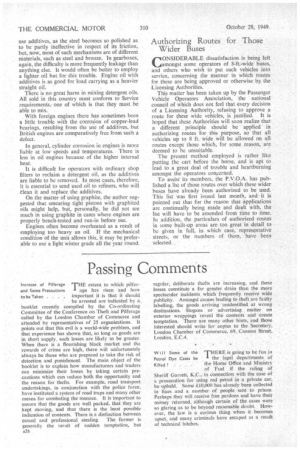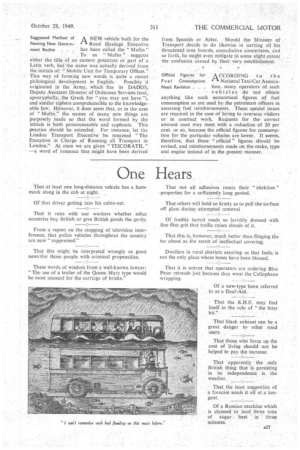Passing Comments
Page 28

Page 29

If you've noticed an error in this article please click here to report it so we can fix it.
Increase of Pilferage THE extent to which pilfer and Some Precautions A age has risen and how
to toe Taken . . . important it is that it should
be arrested are indicated by a, booklet recently compiled by the Co-ordinating Committee of the Conference on Theft and Pilferage called by the London Chamber of Commerce and attended by representatives of 25 organizations. It points out that this evil is a world-wide problem, and that experience has shown that, so long as goods are in short supply, such losses are likely to be greater. When there is a flourishing black market and the rewards of crime are high, there will unfortunately always be those who are prepared to take the risk of detection and punishment. The main object of the booklet is to explain how manufacturers and traders can minimize their losses by taking certain precautions which can 'educe both the opportunity and the reason for thefts. For example, road transport undertakings, in conjunction with the police force, have instituted a system of road traps and many other means for combating the menace. It is important to ensure that the goods are well packed, that they are kept moving, and that there is the least possible indication of contents. There is a distinction between casual and professional stealing. The former is generally the result of sudden temptation, but A26 regular, deliberate thefts are increasing, and these losses constitute a far greater drain than the more spectacular incidents which frequently receive wide publicity. Amongst causes leading to theft are faulty labelling, the goods arriving unidentified at wrong destinations. Slogans or advertising matter on exterior wrappings reveal the contents and create temptation. There are many other hints, and those interested should write for copies to the Secretary, London Chamber of Commerce, 69. Cannon Street,
London, E.C.4. •
Will Some of the THERE is going to be fun,in Petrol Dye Cases be the legal departments of
Killed ? . . . the Home Office and Ministry of Fuel if the ruling of Sheriff Garrett, K.C., in connection with the case of a prosecution for using red petrol in a private car, be upheld. Some £10,000 has already been collected in fines and a number of people sent to prison: Perhaps they will receive free pardons and have their money returned, although certain of the cases were so glaring as to he beyond reasonable doubt. However, the law is a curious thing when it becomes upset, and many criminals have escaped as a result of technical hitches.
Suggested Method of A NEW, vehicle built for the Naming New Governr-1 Road Haulage Executive . merit Bodies . , , has been called the " Mufto." To us " uf to " suggests either the title of an eastern potentate or part of a Latin verb, but the name was actually derived from.• the initials.of: "Mobile Unit for Temporary Offices."This way of forming new words is quite a recent
philological development in English. Possibly it originated in the Army, which has its DADOS, Deputy Assistant Director of Ordnance Services (and, apocryphally, the Greek for "you may not have "), and similar ciphers comprehensible to the knowledgeable few. However, it does seem that, as in the case of " Mufto," the names of 'many new things are purposely made so that the word formed by the initials is both pronounceable and euphonic. This practice should be extended: For instance, let the London Transport Executive be renamed "The Executive in Charge of Running all Transport in London." At once we are given " TEICORATIL " —a word of romance that might have been derived from Spanish or Aztec. Should the Minister of Transport decide to do likewise in nailing all his threatened area boards, consultative committees, and so forth, he might even mitigate to some slight extent the confusion caused by their very establishment.
Official Figures for A CCOR DING to the Fuel Consumption r-S. National Taxi-Car AssociaNeed Revision . . . tion, many operators of. such vehicles do not obtain anything like such economical figures of fuel consumption as are.used by the petroleum officers in assessing fuel reimbursements. These special iSsues are required in the case of hiring to overseas visitors or in contract work. Recfuests for the correct amount used may meet with a reduction of 20 per cent. or so, because the official figures for consumption for the particular vehicles are lower. It seems, therefore, that these " official " figures should be revised, and reimbursements made oh the make, type and engine instead of in the present manner. •




























































































